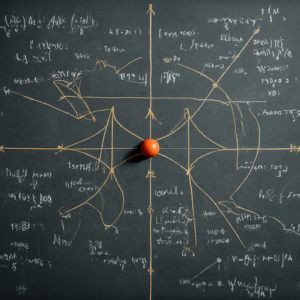Table of Contents
Dive into the heart of particle physics with us as we delve into one of the most important tools in a physicist’s arsenal: Feynman diagrams. Renowned for their ability to map and visualize the behavior of subatomic particles, these diagrams bear the name of their creator, Richard Feynman, a Nobel laureate and one of the 20th century’s most influential physicists. In this article, we will navigate through the intricacies of Feynman diagrams, explore their purpose, and unveil how they have changed our understanding of the universe.
The Concept and Creation of Feynman Diagrams
Understanding the inception and concept of Feynman diagrams is fundamental in grasping their function. Physicist Richard Feynman first introduced these diagrams in the late 1940s as a tool to simplify complex equations in quantum field theory – the theory that explains the behavior of subatomic particles. His initiative was to provide an intuitive way to represent and calculate particle interactions that occur in the quantum world.
Feynman diagrams are essentially pictorial representations of mathematical expressions. Each line, vertex, and direction within the diagram corresponds to a specific mathematical component. Together, they illustrate an event involving a number of particles interacting through electromagnetic force or other kinds of forces in physics.
Feynman’s innovative approach was not immediately accepted by all his peers. Some criticized it as too simplistic, while others saw its potential in bridging the gap between abstract quantum theories and experimental practices. Nevertheless, time and practice have cemented the diagrams’ worth in particle physics.
The beauty of Feynman diagrams is not only in their functional value but also in their profound implication: they exemplify how physicists can build bridges between mathematical equations and physical realities, hence simplifying complex phenomena into comprehensible visualizations.
The Structure and Interpretation of Feynman Diagrams
Feynman diagrams are not random doodles; they follow specific rules and structures that dictate how particles interact. A typical diagram consists of external lines representing incoming and outgoing particles, internal lines depicting virtual particles, and vertices where these lines meet, signifying interactions.
Each type of line is associated with a particular kind of particle. Straight lines usually represent fermions (matter particles like electrons), wavy lines denote bosons (force-carrying particles like photons), while dashed or dotted lines often symbolize other kinds of particles. The direction of the lines in the diagram can denote whether a particle is matter or antimatter.
Interpreting a Feynman diagram requires a blend of imagination and mathematical skills. Although they provide a visual image, these diagrams should not be seen as real-space-time pictures but rather a tool to calculate probabilities of outcomes in quantum events.
An essential point to remember is that Feynman diagrams do not depict motion but rather interactions. The images illustrate the exchange of energy and momentum at each vertex point, which reveals the forces between the particles involved.
The Impact and Importance of Feynman Diagrams
Despite initial skepticism, Feynman diagrams have since become a cornerstone in theoretical physics. They have been instrumental in the development of quantum electrodynamics (QED), for which Feynman shared the Nobel Prize in Physics in 1965.
Feynman diagrams’ value also extends beyond QED. They have been adapted to other areas of quantum field theory, such as quantum chromodynamics and the electroweak theory. These theories help us comprehend the fundamental forces of nature – electromagnetism, strong interaction, and weak interaction – apart from gravity.
Furthermore, these diagrams have influenced the development of string theory, a theoretical framework that aims to reconcile quantum physics and general relativity by proposing that the fundamental constituents of reality are not point-like particles but one-dimensional strings.
In the grand scheme of things, Feynman diagrams embody the power of visualization in solving complex problems. They remind us of the importance of intuition and creativity in scientific endeavors, exemplifying that science is not solely about computation but also about imagination.
Conclusion
Feynman diagrams are more than mere illustrations; they are a testament to human ingenuity. Their power lies in their simplicity, embodying complex quantum physics in a digestible format, reflecting the beauty and elegance of the natural world. As we have explored, they have been instrumental in furthering our understanding of the universe and continue to influence scientific research. In the hands of curious and passionate physicists, Feynman diagrams will undoubtedly unlock more secrets hidden within the fabric of the cosmos.
